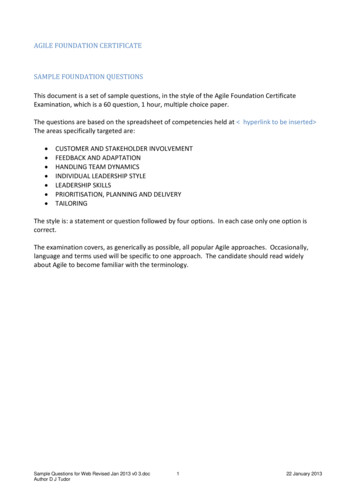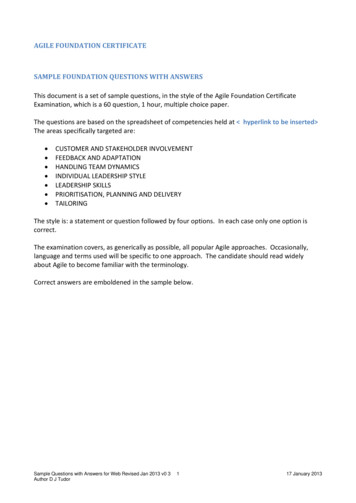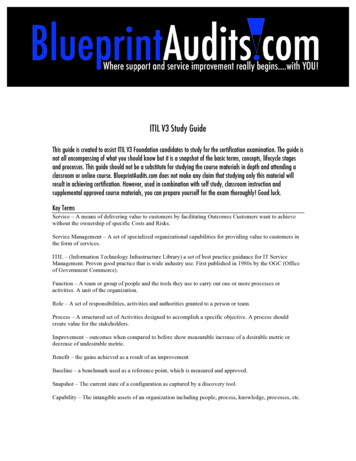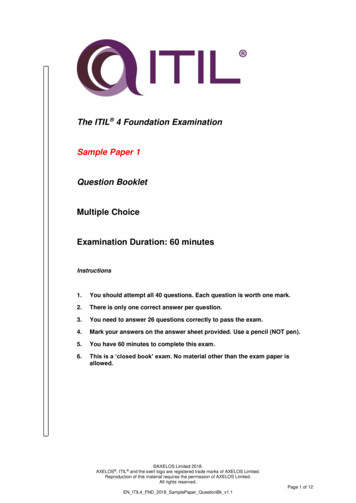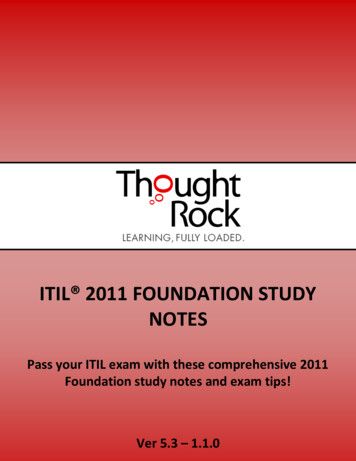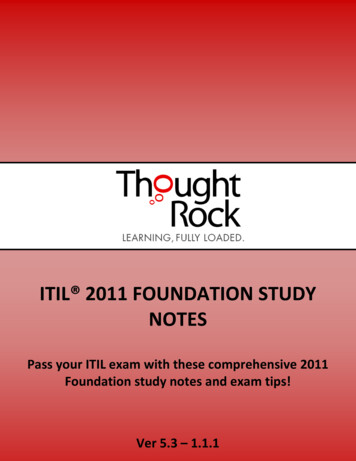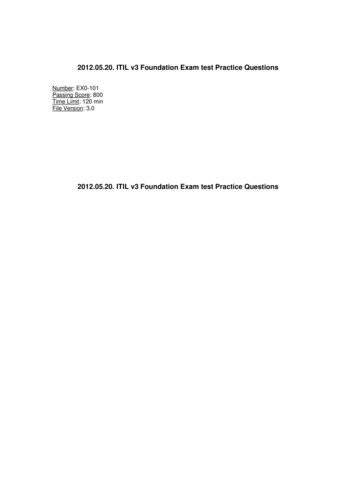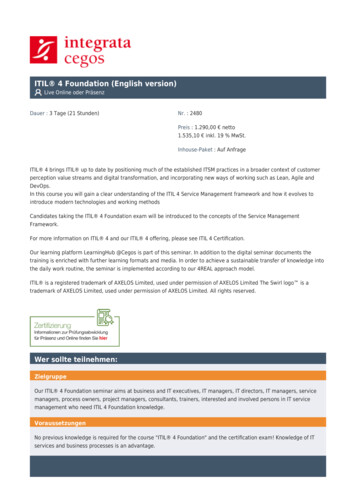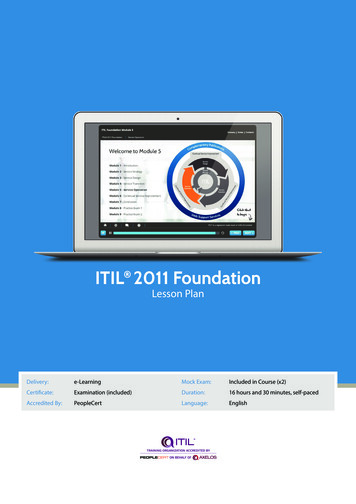
Transcription
ITIL FoundationITIL 4 Edition2
Published by TSO (The Stationery Office), part of Williams Lea, and available from:Onlinewww.tsoshop.co.ukMail, Telephone, Fax & E-mailTSOPO Box 29, Norwich, NR3 1GNTelephone orders/General enquiries: 0333 202 5070Fax orders: 0333 202 5080E-mail: customer.services@tso.co.ukTextphone 0333 202 5077TSO@Blackwell and other Accredited AgentsAXELOSFull details on how to contact AXELOS can be found at:https://www.axelos.comFor further information on qualifications and training accreditation, please tionFor all other enquiries, please email: ask@axelos.comCopyright AXELOS Limited 2019All rights reserved. No part of this publication may be reproduced in any form or by any meanswithout permission in writing from AXELOS Limited.Applications to reuse, reproduce or republish material in this publication should be sent to thelicensing team at: licensing@AXELOS.comRegistered office address: 30 Berners Street, London, England, W1T 3LRAXELOS, the AXELOS logo, the AXELOS swirl logo, ITIL , MoP , M o R , MoV , MSP , P3M3 ,P3O , PRINCE2 , PRINCE2 Agile , and RESILIA are registered trade marks of AXELOS Limited.AgileSHIFT is a trade mark of AXELOS Limited.First edition 2019Second impression 20193
ISBN 9780113316076Printed in the United Kingdom for The Stationery OfficeMaterial is FSC certified and produced using ECF pulp, sourced from fully sustainable forests.P002959377 c10 02/194
ContentsWelcome to ITIL 4About this publication1Introduction1.1 IT service management in the modern world1.2 About ITIL 41.3 The structure and benefits of the ITIL 4 framework1.3.1 The ITIL SVS1.3.2 The four dimensions model2Key concepts of service management2.1 Value and value co-creation2.1.1 Value co-creation2.2 Organizations, service providers, service consumers, and otherstakeholders2.2.1 Service providers2.2.2 Service consumers2.2.3 Other stakeholders2.3 Products and services2.3.1 Configuring resources for value creation2.3.2 Service offerings2.4 Service relationships2.4.1 The service relationship model2.5 Value: outcomes, costs, and risks2.5.1 Outcomes2.5.2 Costs2.5.3 Risks2.5.4 Utility and warranty2.6 Summary3The four dimensions of service management3.1 Organizations and people3.2 Information and technology3.3 Partners and suppliers3.4 Value streams and processes3.4.1 Value streams for service management5
3.53.63.4.2 ProcessesExternal factorsSummary4The ITIL service value system4.1 Service value system overview4.2 Opportunity, demand, and value4.3 The ITIL guiding principles4.3.1 Focus on value4.3.2 Start where you are4.3.3 Progress iteratively with feedback4.3.4 Collaborate and promote visibility4.3.5 Think and work holistically4.3.6 Keep it simple and practical4.3.7 Optimize and automate4.3.8 Principle interaction4.4 Governance4.4.1 Governing bodies and governance4.4.2 Governance in the SVS4.5 Service value chain4.5.1 Plan4.5.2 Improve4.5.3 Engage4.5.4 Design and transition4.5.5 Obtain/build4.5.6 Deliver and support4.6 Continual improvement4.6.1 Steps of the continual improvement model4.6.2 Continual improvement and the guiding principles4.7 Practices4.8 Summary5ITIL management practices5.1 General management practices5.1.1 Architecture management5.1.2 Continual improvement5.1.3 Information security management5.1.4 Knowledge management5.1.5 Measurement and reporting5.1.6 Organizational change management6
5.25.35.1.7 Portfolio management5.1.8 Project management5.1.9 Relationship management5.1.10 Risk management5.1.11 Service financial management5.1.12 Strategy management5.1.13 Supplier management5.1.14 Workforce and talent managementService management practices5.2.1 Availability management5.2.2 Business analysis5.2.3 Capacity and performance management5.2.4 Change control5.2.5 Incident management5.2.6 IT asset management5.2.7 Monitoring and event management5.2.8 Problem management5.2.9 Release management5.2.10 Service catalogue management5.2.11 Service configuration management5.2.12 Service continuity management5.2.13 Service design5.2.14 Service desk5.2.15 Service level management5.2.16 Service request management5.2.17 Service validation and testingTechnical management practices5.3.1 Deployment management5.3.2 Infrastructure and platform management5.3.3 Software development and managementEnd note: The ITIL story, one year onAppendix A: Examples of value streamsFurther researchGlossaryAcknowledgements7
Welcome to ITIL 4At this new stage in the development of the IT industry, AXELOS is delighted topresent ITIL 4, the latest step in the evolution of IT best practice. By building on ourexperience and bringing fresh and forward-looking thinking to the marketplace, ITIL4 equips your business to deal with the challenges currently faced by the industry.The adoption of ITIL as the most widely used guidance in the world on IT servicemanagement (ITSM) will continue with ITIL 4. It ensures continuity with existingways of working (where service management is already successful) by integratingmodern and emerging practices with established and proven know-how. ITIL 4 alsoprovides guidance on these new methods to help individuals and organizations tosee their benefits and move towards using them with confidence, focus, andminimal disruption.ITIL 4’s holistic approach raises the profile of service management in organizationsand industries, setting it within a more strategic context. Its focus tends to be onend-to-end product and service management, from demand to value.ITIL 4 is the result of a great amount of global research and development workacross the IT and service management industries; this work has involved activepractitioners, trainers, consultants, vendors, technicians, and business customers.The architect team has collaborated with the wider stakeholders and users of ITIL toensure that the content meets the modern requirements of continuity, innovation,flexibility, and value.ITIL training provides individuals with a structured approach for developing theircompetencies in the current and future workplace. The accompanying guidance alsohelps organizations to take advantage of the new and upcoming technologies,succeed in making their digital transformations, and create value as needed forthemselves and their customers.ITIL Foundation is the beginning of your ITIL 4 journey. It will open your mind to thewider, more advanced guidance provided in the other ITIL publications and trainingthat will support your growth and development.Welcome to the new generation of IT best practice!8
Mark BashamCEOAXELOS Global Best Practice9
About this publicationITIL Foundation is the first publication of ITIL 4, the latest evolution of the mostwidely adopted guidance for ITSM. Its audience ranges from IT and businessstudents taking their first steps in service management to seasoned professionalsfamiliar with earlier versions of ITIL and other sources of industry best practice.ITIL 4 Foundation will: provide readers with an understanding of the ITIL 4 service managementframework and how it has evolved to adopt modern technologies and ways ofworking explain the concepts of the service management framework to supportcandidates studying for the ITIL 4 Foundation exam act as a reference guide that practitioners can use in their work, further studies,and professional development.We hope you will find it useful.About the ITIL storyThe guidance provided in this publication can be adopted and adapted for all typesof organization and service. To show how the concepts of ITIL can be practicallyapplied to an organization’s activities, ITIL Foundation follows the exploits of afictional company on its ITIL journey.This company, Axle Car Hire, is undergoing a transformation to modernize itsservices and improve its customer satisfaction and retention levels, and is using ITILto do this. In each chapter of the text, the employees of Axle will describe how thecompany is improving its services, and explain how they are using ITIL best practiceto do this.ITIL storyline sections appear throughout the text, separated by a distinct border.Axle Car HireAxle Car Hire is a global company, with its headquarters based in Seattle. Axle wasformed 10 years ago, and currently employs approximately 400 staff across Europe,the US, and Asia-Pacific.Initially, the company experienced strong growth and consistently high customersatisfaction ratings. For the first six years, repeat business accounted for around 3010
per cent of all bookings. Shareholders could expect handsome quarterly dividends.However, over the past four years, the company has experienced a downturn.Customer satisfaction ratings have consistently declined and repeat bookings arerare. Competitors are offering new and innovative options to traditional vehiclehire. Car-pooling, ride-share, and driverless cars are big draws. Customers have alsocome to expect online and app interfaces as standard for the company’s services.In this evolving market, Axle Car Hire faces an uncertain future. The board is keen toimprove customer satisfaction levels. They want to attract and retain customers,and improve the company’s bottom line. They’ve appointed a new CIO, Henri. Henriwas chosen for his experience in digitalized services and his track record insuccessful, large-scale IT transformations. He understands the impact of digitalservice offerings, not only for customer satisfaction levels, but also for employeeretention rates.Henri’s strong background in ITIL and ITSM means that he values ITIL certification,and his hiring policy reflects this. Having worked with Design Thinking, DevOps, andAgile methodologies, he believes sustainable business requires a blended approachto ITSM.Henri is keen to see how his team can redefine the car-hire experience and ensurethat Axle Car Hire is the first choice for new and existing customers.Meet the Axle employeesHere are four key employees of Axle Car Hire:Henri Is the new CIO of Axle Car Hire. He is a successful business executive who’sprepared to shake things up. He believes in an integrated approach to ITSM.Su Is the Axle Car Hire product manager for travel experience, and has worked forAxle for the past five years. Su is smart, meticulous, and passionate about theenvironment.Radhika Is the Axle Car Hire IT business analyst, and it is her job to understand theuser requirements of Axle Car Hire staff and customers. She is inquisitive andenergetic, and strives to maintain a positive relationship with all her customers,both internal and external. Radhika works mostly on discovery and planningactivities, rather than in IT operations. She asks a lot of questions and is great atspotting patterns and trends.Marco Is the Axle Car Hire IT delivery manager. He is process-driven and continuallyreferences the ITIL framework to help him manage positive service relationships.However, Marco has had little exposure to a blended or collaborative approach toservice management.11
CHAPTER 1INTRODUCTION12
1 Introduction1.1 IT service management in the modern worldAccording to the World Trade Organization,1 services comprise the largest and mostdynamic component of both developed and developing economies. Services are themain way that organizations create value for themselves and their customers.Almost all services today are IT-enabled, which means there is tremendous benefitfor organizations in creating, expanding, and improving their IT service managementcapability.Technology is advancing faster today than ever before. Developments such as cloudcomputing, infrastructure as a service (IaaS), machine learning, and blockchain haveopened fresh opportunities for value creation, and led to IT becoming an importantbusiness driver and source of competitive advantage. In turn, this positions ITservice management as a key strategic capability.To ensure that they remain relevant and successful, many organizations areembarking on major transformational programmes to exploit these opportunities.While these transformations are often referred to as ‘digital’, they are about morethan technology. They are an evolution in the way organizations work, so that theycan flourish in the face of significant and ongoing change. Organizations mustbalance the need for stability and predictability with the rising need for operationalagility and increased velocity. Information and technology are becoming morethoroughly integrated with other organizational capabilities, silos are breakingdown, and cross-functional teams are being utilized more widely. Servicemanagement is changing to address and support this organizational shift and ensureopportunities from new technologies, and new ways of working, are maximized.Service management is evolving, and so is ITIL, the most widely adopted guidanceon IT service management (ITSM) in the world.1.2 About ITIL 4ITIL has led the ITSM industry with guidance, training, and certification programmesfor more than 30 years. ITIL 4 brings ITIL up to date by re-shaping much of theestablished ITSM practices in the wider context of customer experience, valuestreams, and digital transformation, as well as embracing new ways of working, suchas Lean, Agile, and DevOps.13
ITIL 4 provides the guidance organizations need to address new servicemanagement challenges and utilize the potential of modern technology. It isdesigned to ensure a flexible, coordinated and integrated system for the effectivegovernance and management of IT-enabled services.1.3 The structure and benefits of the ITIL 4 frameworkThe key components of the ITIL 4 framework are the ITIL service value system (SVS)and the four dimensions model.1.3.1 The ITIL SVSThe ITIL SVS represents how the various components and activities of theorganization work together to facilitate value creation through IT-enabled services.These can be combined in a flexibl
ITIL Foundation is the first publication of ITIL 4, the latest evolution of the most widely adopted guidance for ITSM. Its audience ranges from IT and business students taking their first steps in service management to seasoned professionals familiar with earlier versions of ITIL and other sources of industry best practice. ITIL 4 Foundation will: provide readers with an understanding of the .

